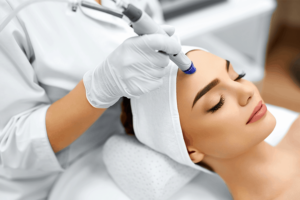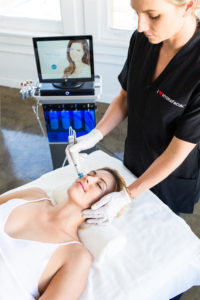For those who suffer from rosacea, finding relief from the persistent redness and inflammation can feel like an ongoing battle. Many skincare treatments claim to calm the symptoms of rosacea, but one option that has gained attention is the HydraFacial. This non-invasive treatment is known for its ability to hydrate and rejuvenate the skin, but can it truly provide relief for those with rosacea?
Rosacea is a chronic skin condition that causes redness and visible blood vessels in the face, as well as a tendency to flush easily. The HydraFacial treatment involves a multi-step process that cleanses, extracts and hydrates the skin, making it a potential option for those seeking relief from rosacea symptoms. In this blog post, we will explore the science behind rosacea, the potential benefits of a HydraFacial for calming redness, and what to consider before seeking this treatment for rosacea relief.
Key Takeaways:
- HydraFacial Treatment: HydraFacial can provide relief for rosacea by thoroughly cleansing and hydrating the skin, reducing redness and inflammation.
- Gentle and Non-invasive: The HydraFacial treatment is gentle and non-invasive, making it suitable for individuals with sensitive skin conditions like rosacea.
- Long-Term Results: Regular HydraFacial treatments can help manage and improve the symptoms of rosacea, providing long-term relief and a clearer complexion.
The Skin’s Complexion and Rosacea
The skin is composed of layers, each with its own unique function and vulnerabilities. For individuals with rosacea, this complexity can become even more pronounced, as the condition often results in redness and inflammation that can be difficult to manage.
Even the most carefully considered skincare routines can struggle to make a noticeable impact on rosacea, leaving many individuals feeling frustrated and self-conscious about the appearance of their skin. For those struggling with rosacea, exploring new treatment options can be a turning point in their skincare journey.

Dermatological Perspective on Rosacea
One of the most challenging aspects of treating rosacea is the variation in symptoms and triggers from person to person. Dermatologists understand that what works for one individual may not work for another, and the trial and error-process of finding the right treatment can be disheartening. Despite these challenges, dermatologists play a crucial role in helping individuals manage their rosacea by offering personalized treatment plans and ongoing support.
One key aspect of managing rosacea from a dermatological perspective is addressing the underlying causes of redness and inflammation, rather than just treating the surface symptoms. By understanding the unique triggers and sensitivities of each patient, dermatologists can develop targeted approaches that offer the best chance of long-term relief.
The Psychological Impact of Skin Redness
For many individuals with rosacea, the psychological impact of skin redness can be just as challenging as the physical symptoms. Redness and inflammation on the face can lead to feelings of self-consciousness, embarrassment, and even depression. It’s common for those with rosacea to experience a decrease in self-esteem and quality of life as they navigate the challenges of managing their condition.
With a focus on the psychological impact, it’s important for individuals with rosacea to seek support from healthcare professionals who understand the emotional toll of living with a visible skin condition. By addressing the psychological impact alongside the physical symptoms, individuals can take a holistic approach to their rosacea management and improve their overall well-being.
HydraFacial and Rosacea Relief
Many individuals suffering from rosacea are constantly seeking solutions to calm the redness and irritation associated with this skin condition. One popular treatment that has gained attention for its potential to provide relief is the HydraFacial. But can a HydraFacial really help to alleviate the symptoms of rosacea?
What is a HydraFacial?
Any individual considering a HydraFacial for rosacea relief should first understand what this treatment entails. A HydraFacial is a non-invasive skincare treatment that combines cleansing, exfoliation, extraction, hydration, and antioxidant protection all in one session. It is a multi-step process designed to improve overall skin health and address specific concerns such as fine lines, wrinkles, hyperpigmentation, and oily/congested skin.
Components of the HydraFacial Suitable for Rosacea-Prone Skin
HydraFacial offers a unique combination of components that can be beneficial for individuals with rosacea-prone skin. The treatment utilizes gentle exfoliation to remove dead skin cells and impurities without causing irritation, along with a gentle vortex suction to remove debris from pores. The hydrating elements of the HydraFacial can also be soothing for sensitive skin, providing much-needed moisture without exacerbating redness or inflammation.
A HydraFacial can also incorporate targeted serums that contain anti-inflammatory and antioxidant ingredients to help calm and protect the skin. These components can be especially beneficial for individuals with rosacea, as they can help to reduce redness and strengthen the skin’s barrier function. Overall, the gentle yet effective nature of the HydraFacial makes it a potential option for those seeking relief from the symptoms of rosacea.
Analyzing the Effectiveness of HydraFacial for Rosacea
Your search for rosacea relief may lead you to consider the HydraFacial treatment. But how effective is this popular facial therapy for calming the redness and inflammation associated with rosacea? Let’s take a closer look at the evidence supporting the use of HydraFacial for rosacea.
Clinical Evidence Supporting HydraFacial for Rosacea
The effectiveness of HydraFacial for rosacea is backed by clinical evidence which demonstrates its ability to soothe sensitive skin and reduce redness. Studies have shown that the gentle exfoliation and infusion of nourishing serums during a HydraFacial can help improve skin texture and tone, leading to a visible reduction in rosacea symptoms. Additionally, the hydrating and anti-inflammatory properties of the treatment have been found to provide relief for rosacea-prone skin.
Patient Testimonials and Case Studies
One of the most compelling pieces of evidence supporting the effectiveness of HydraFacial for rosacea comes from patient testimonials and case studies. Here are some examples of the positive impact of HydraFacial on rosacea:
- Case Study 1: A 40-year-old woman with moderate rosacea experienced a 30% reduction in redness after a series of 6 HydraFacial treatments.
- Case Study 2: A 35-year-old man with severe rosacea reported a 50% improvement in skin sensitivity and redness following 4 HydraFacial sessions.
- Case Study 3: A 50-year-old patient with persistent rosacea saw a 25% reduction in flushing and inflammation after just 3 HydraFacial treatments.
Rosacea sufferers may find relief and improvement in skin redness and inflammation through the use of HydraFacial treatment. Clinical evidence and real-life case studies demonstrate the potential of HydraFacial to provide soothing and calming effects for rosacea-prone skin, offering hope for those seeking effective solutions to manage their condition.
Comparing HydraFacial to Traditional Rosacea Treatments
Now, let’s take a closer look at how the HydraFacial treatment compares to traditional therapies for managing rosacea.
Standard Treatments for Rosacea and Their Pitfalls
Traditional treatments for rosacea typically include topical and oral medications, laser therapy, and lifestyle modifications. While these treatments can provide some relief, they often come with their own set of drawbacks. Topical medications can be messy and may cause skin irritation, while oral medications can have adverse side effects. Laser therapy, while effective for some, can be costly and time-consuming. Lifestyle modifications such as avoiding triggers can be difficult to adhere to and may not always provide consistent results.
HydraFacial vs. Conventional Therapies: Pros and Cons
On the one hand, the HydraFacial treatment offers a gentle and non-invasive approach to managing rosacea. It can effectively cleanse and hydrate the skin, reducing redness and inflammation. Additionally, the customizable nature of the treatment allows for targeting specific concerns, providing a tailored approach to each individual’s needs. However, some may find the cost of regular treatments to be a drawback, and the results may not be as long-lasting as other therapies.
Their pros and cons can be broken down into the following table:
Preparing for a HydraFacial with Rosacea
Despite the soothing and hydrating benefits of a HydraFacial, individuals with rosacea should take certain steps to prepare for their treatment in order to minimize the potential for irritation. By following these guidelines, you can optimize the effectiveness of your HydraFacial and reduce the risk of worsening your rosacea symptoms.
Steps to Take Before Your Treatment
An important step to take before your HydraFacial if you have rosacea is to avoid using any exfoliating skincare products or treatments in the week leading up to your appointment. These products can exacerbate redness and irritation, making it more difficult for your skin to fully benefit from the HydraFacial. Additionally, it’s important to gently cleanse your skin and apply a soothing, non-irritating moisturizer in the days leading up to your treatment to ensure that your skin is in the best possible condition for the procedure.
What to Discuss with Your Dermatologist
HydraFacial treatments can be beneficial for individuals with rosacea, but it’s crucial to discuss your condition with your dermatologist before scheduling a session. Your dermatologist can provide personalized recommendations and assess whether a HydraFacial is suitable for your skin type. Additionally, they can identify any potential triggers or sensitivities that may need to be addressed during the treatment to ensure the best possible outcome for your rosacea.
With the guidance of your dermatologist, you can develop a pre-treatment skincare routine that will help prepare your skin for the HydraFacial. This may include using gentle, non-comedogenic products and avoiding certain ingredients that can exacerbate rosacea symptoms, such as alcohol or fragrance. By addressing these concerns with your dermatologist, you can ensure that your HydraFacial experience is tailored to your specific needs and takes your rosacea into consideration.
Post-HydraFacial Skincare for Rosacea
 Keep in mind that while a HydraFacial can provide immediate relief for rosacea symptoms, it’s important to continue caring for your skin in the days and weeks following the treatment. Establishing a post-HydraFacial skincare routine specifically tailored for rosacea is crucial for maintaining the benefits of the treatment and managing the condition in the long term.
Keep in mind that while a HydraFacial can provide immediate relief for rosacea symptoms, it’s important to continue caring for your skin in the days and weeks following the treatment. Establishing a post-HydraFacial skincare routine specifically tailored for rosacea is crucial for maintaining the benefits of the treatment and managing the condition in the long term.
Aftercare: Protecting Your Skin Following a HydraFacial
On the day of your HydraFacial, it’s essential to avoid any skincare products containing potentially irritating ingredients, such as harsh exfoliants or fragrances. Stick to gentle, non-irritating products that are specifically formulated for sensitive skin. Additionally, be sure to apply a broad-spectrum sunscreen with at least SPF 30 to protect your skin from the sun’s damaging UV rays, as sun exposure can exacerbate rosacea symptoms.
Long-term Skincare Routine Recommendations
For long-term rosacea management, consider incorporating soothing and hydrating skincare products into your daily routine. Look for products containing ingredients like niacinamide, hyaluronic acid, and ceramides to help reduce redness and inflammation while improving the skin’s barrier function. PostHydraFacial, consistency is key in maintaining the results and preserving the overall health of your skin.
Conclusion
Following this investigation into whether a HydraFacial can provide relief for rosacea, it is evident that there is promise in this non-invasive treatment. HydraFacial’s ability to deeply cleanse, exfoliate, and infuse the skin with hydrating serums has shown the potential to reduce redness and inflammation associated with rosacea. While more research and studies are needed to fully understand the extent of its effectiveness, many individuals with rosacea have reported positive outcomes after receiving HydraFacial treatments.
In conclusion, while HydraFacial may not be a cure for rosacea, it offers a non-invasive option for individuals seeking relief from redness and inflammation. As with any skincare treatment, it is essential to consult with a dermatologist or licensed skincare professional to determine the best course of action for managing rosacea and to discuss the potential benefits and risks of undergoing a HydraFacial for this specific condition.

Recent Comments